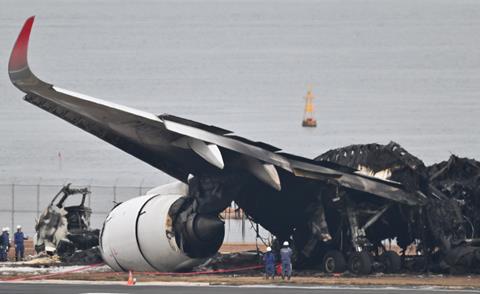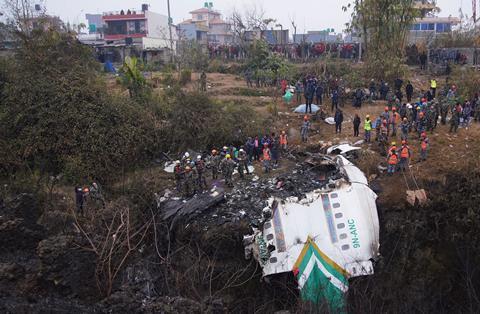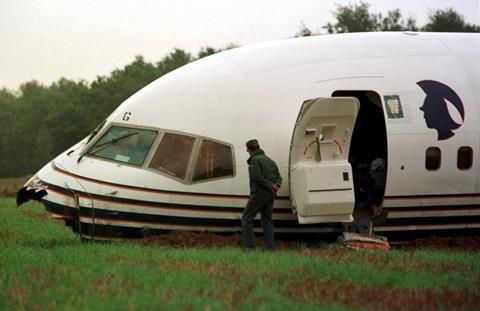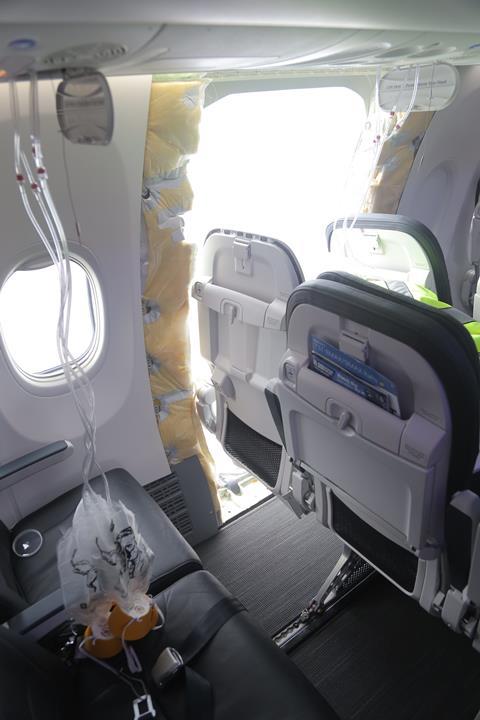No sooner had 2023 ended – boasting an exceptional world airline safety record – than the new year delivered a sharp reminder that relaxing vigilance is not an option for the aviation industry, even when things seem to be going well.
On 2 January 2024, two aircraft were destroyed at Tokyo’s Haneda airport in a runway collision at night between a landing Japan Airlines (JAL) Airbus A350 and a Japan Coast Guard De Havilland Canada Dash 8 that appears to have been lining up for an un-cleared take-off.
Fortunately, all 387 on board the A350 were evacuated before fire consumed the hull, but five out of the six crew on board the Dash 8 died. The survivor tally for the widebody is a testament to modern aircraft design and construction, and also to the JAL crew’s skill during its evacuation.

As for 2023, it was a very safe year: even better than a string of excellent years over our decade-long review period since 2014 (see graph, below).
Using Flight International’s long-accepted definition of commercial airline flights – whatever the aircraft size or power unit – there were only six fatal accidents globally in 2023, with these resulting in 115 onboard deaths. That followed 2022’s respective figures of 12 and 229.
There were no fatal accidents involving jet airliners, and the largest aircraft lost was an ATR 72-500 twin-turboprop. The other accidents involved small twin-engined commuter types – specifically the Beechcraft C99 and Embraer EMB-110 – plus single-engined Cessna Caravans and an Antonov An-26.
| World airline fatal accidents and fatalities, 2014-2023* | ||||||||||
|---|---|---|---|---|---|---|---|---|---|---|
| Year | 2014 | 2015 | 2016 | 2017 | 2018 | 2019 | 2020 | 2021 | 2022 | 2023 |
| Fatal accidents | 19 | 9 | 13 | 12 | 14 | 22 | 12 | 15 | 12 | 6 |
| Fatalities | 671 | 176 | 306 | 56 | 543 | 297 | 332 | 134 | 229 | 115 |
| Source: FlightGlobal *Including fatal events known to be caused by deliberate action | ||||||||||
The 15 January Yeti Airlines ATR 72 crash, in which 68 passengers and four crew were killed (see accident listings download at foot of article) also was the only remarkable fatal loss reported during the year.
A Nepalese investigation has concluded that the pilot monitoring, who was an instructor checking the pilot flying the approach to Pokhara’s new airport, when asked to select the flaps from 15° to 30° to prepare for landing, instead retarded both the engine condition levers, which shut the engines down.
Having done that, it looks as if neither pilot understood what had happened, because they did not act to correct it and the aircraft stalled and crashed. It is difficult to know how the airline training department, when studying the report to learn from it, could usefully react to what looks like complete absent-mindedness on the part of the instructor.

Writing in her forward to the latest Boeing Statistical Summary of Commercial Jet Airplane Accidents (STATSUM), Elizabeth Martin, the airframer’s vice-president of enterprise safety and mission assurance, observes that accident rates continue to drop – in all regions. Boeing believes that the reasons for the improvement are many, but that global collaboration and sharing best practice is a consistent contributor.
RADICAL RETHINK
Boeing itself, in the traumatic aftermath of two fatal crashes of 737 Max 8 airliners in Indonesia and Ethiopia in 2018 and 2019, has undergone a radical rethink of its approach to literally everything about its role as an aircraft designer, builder, and provider of global customer support for its products in the modern era.
The company now sees itself as a maker of products for a diverse global marketplace, and has set up a much closer customer support system to improve feedback from operators.
“Boeing designs and builds aircraft that must operate safely every second of every day in every region of the world. We take that responsibility seriously,” Martin says. “Data is a powerful tool to proactively manage safety risks, and it helps the entire industry… to continue to enhance safety in the worldwide fleet”.
“This year’s [STATSUM] report offers a deeper, more global view of actionable data to help us make that progress,” she says, for the first time organised by region, in alignment with ICAO practice.
Previously, the report had presented these statistics in a two-region format: US and Canada, and rest of the world. Martin notes of the adjustment: “With air traffic in every region of the world expected to grow at a rate faster than that of North America, it is time for a more globally diverse approach when reviewing the data.”
The world has become so accustomed to safety figures like those for the year just ended that a reminder of how bad things used to be – and not that long ago – might put them in perspective.
In Flight International’s safety review of 1999, the number of fatal accidents recorded was 48, with 730 fatalities. The respective average annual figures for the 1990s as a whole were 48 and 1,195.
It is useful to review how the industry got its safety performance from 1990s levels to where it is now, because a full understanding of what it takes to produce high standards of safety should help the industry to remain safe.
As the 1990s progressed, increasingly ICAO, IATA and civil aviation authorities in Europe and the USA set in train a succession of safety oversight systems and technical advances that laid the foundations for major safety performance advances in the new century.

The US Federal Aviation Administration (FAA) set up its International Aviation Safety Assessment programme, and Europe its Safety Assessment of Foreign Aircraft, while ICAO ramped up its Universal Safety Oversight Audit Programme (USOAP).
Those actions put pressure on states and carriers everywhere to implement auditable safety management systems – they had to do so if they wanted their airlines to operate into the two biggest air travel markets in the world.
Meanwhile, the USOAP is now a regular audit of each state’s safety oversight and of their capability to ensure adherence to ICAO Standards and Recommended Practices, with the results published.
In the USA, the FAA initiated its Commercial Aviation Safety Team with a view to eliminating fatal accidents, and the EU’s then-Joint Aviation Authorities – now succeeded by the European Union Aviation Safety Agency (EASA) – set up its equivalent, the European Plan for Aviation Safety.
Following the loss of an American Airlines Boeing 757 at Cali, Colombia in December 1995 in a controlled flight into terrain accident, the FAA encouraged the rapid entry into service of the first terrain awareness warning systems, almost eliminating a category of accident that had been the biggest killer of airline passengers and crew.
Finally, in the 2000s IATA made its Operational Safety Audit compulsory for all member airlines.
That is how the industry got here, but now it must stay here – or get even better.
PUBLISHED CONCERNS
It is probably not a coincidence that the dramatic runway incursion collision at Haneda followed the FAA publishing its concerns following a series of near-miss runway incursion incidents in the USA in the last several years, but particularly during the winter of 2022-2023.
In aviation, safety trends discovered domestically are often international issues also. Fortunately, the FAA has initiated a study to work out the best way to deal with this real risk, but its inquiry was in danger of becoming just another bureaucratic exercise. Now, the Haneda collision has emphatically delivered proof that the runway incursion risk is real, meaning the study is more likely to be acted on.
A parallel report by the FAA looked into the effectiveness of the US National Airspace System – in other words air traffic control and airport infrastructure, for which it is directly responsible. It concludes that it is suffering from chronic lack of investment and shortages of expert staff.
The review team, which included National Transportation Safety Board (NTSB) members, wrote to FAA administrator Michael Whitaker reporting that “these serious incidents illuminate significant challenges to the provision of air traffic services by the ATO [Air Traffic Organization]. These challenges – in the areas of process integrity, staffing and facilities, equipment and technology – all have ties to inadequate, inconsistent funding.”
Controllers are often working “historically high levels of overtime”, it adds, increasing the risk of fatigue-related mistakes. “Together, these challenges contribute to increased safety risk and should be regarded as incident precursors,” the report states.
The FAA, therefore, finds itself extremely busy, but may not have the resources to carry out recommendations following the studies it has commissioned.
Meanwhile, 2024’s arrival rapidly delivered another warning to the industry – and particularly to the FAA and Boeing, both of whom have been under huge pressure since the 737 Max crashes late last decade.
On 5 January, an Alaska Airlines 737 Max 9 suffered a rapid decompression passing 16,500ft in the climb out of Portland, Oregon airport as a result of a mid-cabin emergency door plug blowing out. No-one was hurt and the aircraft returned to land safely at Portland, but a boy sitting not far from the exit had his shirt torn off by the rush of air escaping the aircraft.

Photographs of the exterior of the aircraft after landing show the doorway plug to have separated cleanly, not causing visible damage to the airframe structure as it departed.
NTSB chair Jennifer Homendy has insisted the depressurisation event be classifiable as an accident, not an incident, pointing out how much more serious it would have been if it had happened at cruising altitude, where the pressure differential is much higher, and passengers might have released their seatbelts.
The FAA swiftly issued an emergency airworthiness directive requiring the grounding of all 737 Max 9s that are equipped with emergency exit door plugs, pending inspection and determination of the cause of the door plug separation.
The accident aircraft had been delivered new to its operator about three months before the event. Safety consultant and former NTSB member John Goglia has speculated that the fault is likely to be a quality control problem either at Boeing, or at 737 fuselage supplier Spirit AeroSystems.
Another safety concern that the international aviation community agrees needs to be addressed is pilot mental health.
The 2015 Germanwings Airbus A320 crash in the French Alps emphasised the danger of not addressing it: a mentally troubled co-pilot deliberately crashed the aircraft he was flying, killing all on board. This put the subject in the spotlight, but it was not the first nor the only such disaster.
ASSESSMENT METHODS
EASA says: “Currently, there are no specific, validated mental health assessment methods for aviation use, incorporating the specific operational needs, to address the issues identified. Research is needed to further detail the specific needs, and to develop and validate assessment methods or to assess the applicability of existing methods for use in the aviation environment.”
Both EASA and the FAA are concerned that the way pilot mental health is approached at present has the effect of making pilots – and air traffic controllers – hide the problem and fail to seek treatment for fear of losing their job.
Homendy, who set up a roundtable discussion on pilot mental health in December 2023, has commented: “It’s somewhat of an open secret that current rules incentivise people to either lie about their medical history when it comes to mental health or avoid seeking help in the first place.” She adds: “I am frankly concerned about the safety consequences of a system that unintentionally shames and silences people who are struggling.”

The USA has seen recent examples of non-fatal events that highlight the issue. In 2022, a Delta Air Lines first officer threatened a captain with a gun in flight. The incident came to light when, in October 2023 he was charged with the offence.
In November 2023 an Alaska Airlines pilot travelling in the jump seat of a San Francisco-Seattle flight attempted to shut down the engines, but the crew prevented him. He later claimed to have taken “magic mushrooms”, which have a psychedelic effect, because he was having a nervous breakdown. He has been charged with attempted murder.
In the UK, the Air Accidents Investigation Branch published a report into a fatal event involving a Cessna 210M (G-TOTN) on the Isle of Man on 17 July 2023. The lone pilot took off from Ronaldsway airport and deliberately flew it into the cliffs at Bradda Head shortly afterwards.
Pilot suicide on commercial flights in the last three decades has not involved only Europeans and North Americans. A Japanese, a Moroccan, an Egyptian, a Mozambican, a Botswanan, and a Singaporean, among others, have all been afflicted.
The Flight Safety Foundation’s Aviation Safety Network accident database shows a marked acceleration in the number of flights brought down by pilot suicide since the beginning of the 1990s, and this acceleration has continued in the new century. It is undoubtedly a modern flight safety hazard.
Perhaps Homendy should have the last word on the subject: “In practice, if not on paper, the FAA’s system for certifying pilots and mechanics has not kept up with the science around mental health, let alone modern attitudes.
“Regardless of their profession, people must feel safe getting the help they need when they need it. And leaders like us need to talk about it, get comfortable being uncomfortable, to help provide a safe space for others to get treatment.”
Our annual accident listing uses data from Flight International’s research, in association with Ascend by Cirium.
Supporting documents
Click link to download and view these filesFlight International full-year accident listings 2023
PDF, Size 0.95 mb





















